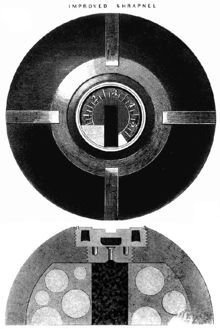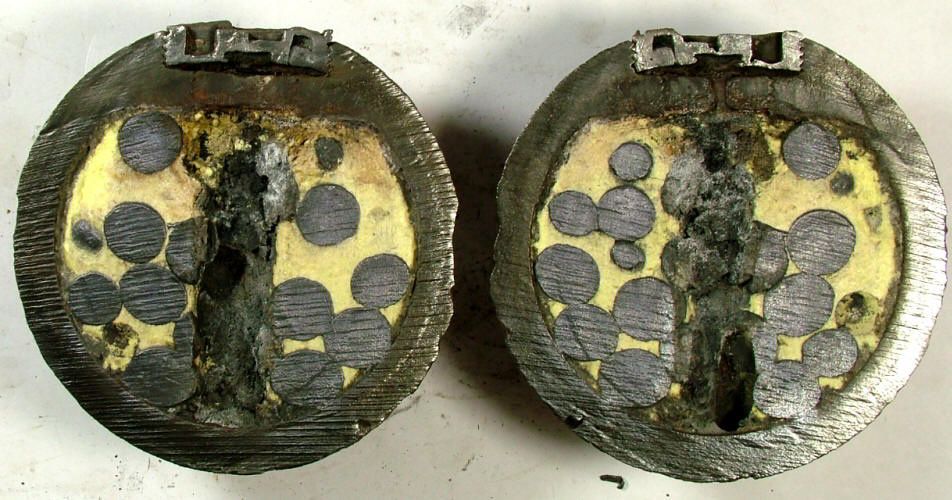
 |
|
|
|
|
#1 |
|
(deceased)
Join Date: Dec 2004
Location: Portugal
Posts: 9,694
|
This would be a grenade for a 5 1/2" howitzer, those equiping the defence redoubts of the Lisbon protection against the third Napoleonic invasion (1810-11).
I assume this is a rational conclusion, as this bomb came with no ID evidence, but the its caliber and geographic source largely appoints to such direction. There were 5 1/2" howitzers in all countless redoubts and fortifications of this war episode. Judging by its irregular exterior, it looks more like forged than cast, which i admit to be a nonsense inferrement. Another surprising (for me) particular is that, its fuse orifice is rather narrow, comparing to the others i have seen, which look like measuring at least the double. Noteworthy is that its hollow space is not completely empty; probing it with a stick i find that half ot its space has some kind of contents. Its colour looks too light to be explosive, i would say. I have poured out a tiny bit and set fire to it; it hasn't actualy gone aflame, but it didn't remain completely inert, forming a darker and thiker dust, hence giving me an ilusion that it isn't plain earth. It might as well be a mix of both, dust having penetrated through the hole and convering whatever contents is inside. But my question is more focused on the hole width; does any of the members know how fuse devices functioned those days ? Are they (only) a wood plug containing a (regulable) match cord in a narrow hole ? Why the significant difference in the different grenade hole widths ? Different fuse systems ... narrow ones earlier, large ones later? Your comments and possible referring illustrations will be appreciated. . |
|
|

|
|
|
#2 |
|
(deceased)
Join Date: Dec 2004
Location: Portugal
Posts: 9,694
|
C'mon Gentlemen,
Fire at will 
|
|
|

|
|
|
#3 |
|
Member
Join Date: Mar 2006
Location: Room 101, Glos. UK
Posts: 4,264
|
the lines of torres vedras
 what context was it found in? spherical shells were transported with the fuse hole plugged with tow, and the fuze was added just before firing. the shells themselves might also be shipped in a padding of tow (fibrous material, hemp, cotton, etc.) or with a wooden plug. if the example was buried and it was wet enough to corrode the exterior that badly, the black powder filler (bursting charge) would have the active ingredients dissolved out by the ground water, and tow or plug could have filled the interior to some extent, and decomposed. howitzer shells generally had the area where the fuse was inserted re-enforced to withstand being fired. fuse holes were tapered to fit the factory made tapered beech fuse plug generally used, which would have had a factory cut & timed paper gunpowder fuse inserted (4,4.5,5 sec were std. in the british army of the time). the bursting charge was sometimes supplemented with lead balls and/or combustibles like tar/pitch or sulphur which could take a fair amt. of the interior space. the spherical shells were generally strapped with iron bands to a wooden 'sabot' base, not inserted in the cannon loose. windage would light the fuse which faced forwards when fired. i found a reference that a 5.85 in. coehorn mortar (US) had a 0.875 in. fuse opening. the same round could be used in a similarly sized howitzer. specific howitzer shells had smaller fuse holes. naval shells in the 6in. range could have 0.65 to 0.75 in. fuse openings. later (after 1829ish) fuses were changing to metal & screwed into the shell, generally with larger threaded openings. impact, and timed fuses of various types were used. the US and CSA used not only wooden plug fuses but metal ones, screwed ones, mechanical timers, etc. during the american civil war (war between the states). Last edited by kronckew; 18th January 2013 at 12:14 PM. |
|
|

|
|
|
#4 |
|
(deceased)
Join Date: Dec 2004
Location: Portugal
Posts: 9,694
|
Ah, you wouldn't let me down, Wayne
 . .I will need some time to digest all the material you are providing here  . .Your'e quite right in naming the defences as the lines of Torres Vedras, commonly kown as linhas de Torres. I wouldn't know the context this greande was found in. The guy who traded it with me bought it from one of the numerous antique shops once active in the road from Sintra do Ericeira; almost all such antiquaries are now closed. As i said, i am basing my conclusion that this was an ammunition from the fortifications built for the Lisbon defence lines on the fact that this was the caliber used in such redoubts, whereas howitzers used on the field, both Portuguese and French, had a 6" caliber. Here i must make a correction to my previous post. While the over 150 forts and redoubts were garnished by: 40.000 men, twenty 24 pounder, three hundred sixty 12 pounder,hundred ninety five 9 pounders and fourty three 6 pounder, there were only seven 51/5" howitzers. I have phoned the previous owner and he admits having removed the topic rust crust from the grenade, reason why, despite being so irregular in shape, it looks so 'clean'. The fuse opening 'admittedly' tapered is now disfigured but, its virtual diameter, measures 1 cm (0,394"), definitely a narrow orifice, potentialy too small to allow for lead balls introduction. I wouldn't be surprised that the various technical data, shipment padding method, fuse delay timer and other, followed British standards. |
|
|

|
|
|
#5 | |
|
Member
Join Date: Mar 2006
Location: Room 101, Glos. UK
Posts: 4,264
|
sadly, i so far can't find what the standard was at the time. 1796 is the date the brits held to a standard for sabres, artillery was i think more hit & miss.
 0.32 and 0.36 in. lead balls were quit often used in the states for civilian pistols and rifles, but were not used in military muskets or pistols of the time. quite possible it was just filled with an incendiary ,ie. sulfur, and cored for the bursting charge thru the hole, which then had a clay plug & fuse combo. shells were cast in sand molds with the central sphere of sand/clay that would be removed thru the hole later. the hole was from a clay rod that supported the central sphere. some shells were cast with a central dodecahedron which thus ensured a varied wall thickness and more consistent fragmentation. one key is in the name 'shell', the wall thickness had to be thick enough to withstand firing with maximum charge, but still thin enough to readily burst with the amt. of powder that could be held internally. a small fuse hole would be more effective as it would leak less gas. hand grenades of course could have a nice thin shell that fragmented easily and had lots of room for nasty lead or steel shrapnel balls and incendiary material. possibly being in the home of the cork oak, they found they could use a smaller hole with a higher quality cork plug? 1865 improved shrapnel shell for a more developed example. the appellation 'shrapnel' was in general use by then for the type of shell with a load of balls and a bursting charge just large enough to release them, not needing additional velocity as the projectile was going fast enough already.  lt. shrapnel's and col. boxer's contribution:  note the sabot. one problem with the good lt.'s design was that friction between the loose balls could set off the bursting charge as the shell was fired. the boxer idea separated the charge and the balls. lt. shrapnel went on to become lt. general shrapnel. col. boxer went on to fame as the proponent of the "The Short Chamber Boxer-Henry .45 caliber" made famous by the movie 'zulu' Quote:
 these examples all had the later metal screwed in fuses. Last edited by kronckew; 18th January 2013 at 07:37 PM. |
|
|
|

|
|
|
#6 | ||
|
(deceased)
Join Date: Dec 2004
Location: Portugal
Posts: 9,694
|
Much obliged for all that input, Wayne
 Quote:
 ... just kiding  Quote:

|
||
|
|

|
 |
|
|